Using LinkedIn as a lead generation platform is a total no-brainer.
Why?
Well, current stats show that LinkedIn has 875 million members, which means that you have a massive pool of business professionals to reach out to.
Plus, you can even use LinkedIn tools, such as Sales Navigator, to narrow down your prospect list.
But if you have never used LinkedIn for lead generation, you might be wondering where to start.
Should you invest in LinkedIn ads? Outreach? Or LinkedIn social media marketing?
Or…
Maybe you have already tried LinkedIn to generate leads, but you haven’t been as successful as you hoped.
If this is the case… Keep reading.
In this article, we will share our LinkedIn lead generation strategy, which brought us 7000 qualified sales leads in 24 months. We will also share some other methods to try out if you aren’t too keen on outreach just yet.
(If you want qualified sales leads, as you did yesterday, why don’t you hop on a free 15-minute strategy call with Salesbread? Let’s see how we can help you.)
Things to consider before using LinkedIn to generate leads
Update your LinkedIn profile
We have actually had clients in the past who struggled to get people to connect with them. After some A/B testing, we realized that their LinkedIn profile was the problem.
We suggested making a few changes, and once the changes were implemented, prospects started to connect with our clients.
This could be as simple as changing your profile photo to something more professional, changing your LinkedIn banner, or updating your “about section” to read more like a sales page and not a resume.
Remember, your LinkedIn profile is like a first impression.
If it comes across as unprofessional, the chances of prospects interacting with you will be few and far between.
Linkedin has some tips for creating the perfect profile, which you can read about here
Some of these tips include things like:
- Having a professional photo that takes up 60% of the frame
- Using a LinkedIn banner
- Not using buzzwords like : “Passionate, reliable, expert, creative.”
- Spotlight the services you offer, making it easy for prospects to know exactly what you do and how to reach you.
Below is an example of my profile:
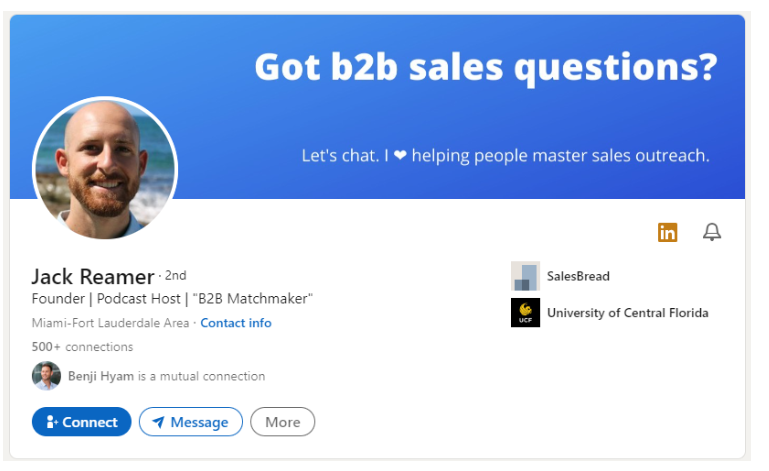
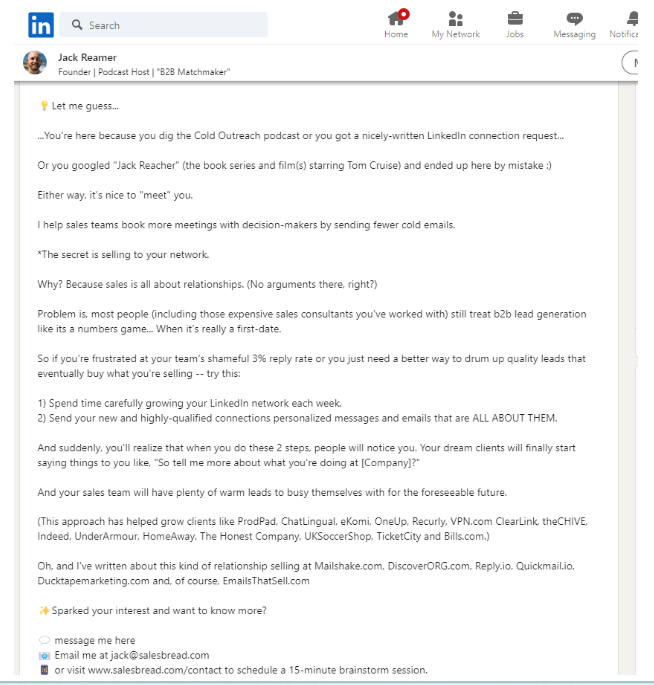
Now compare it to the profile below:
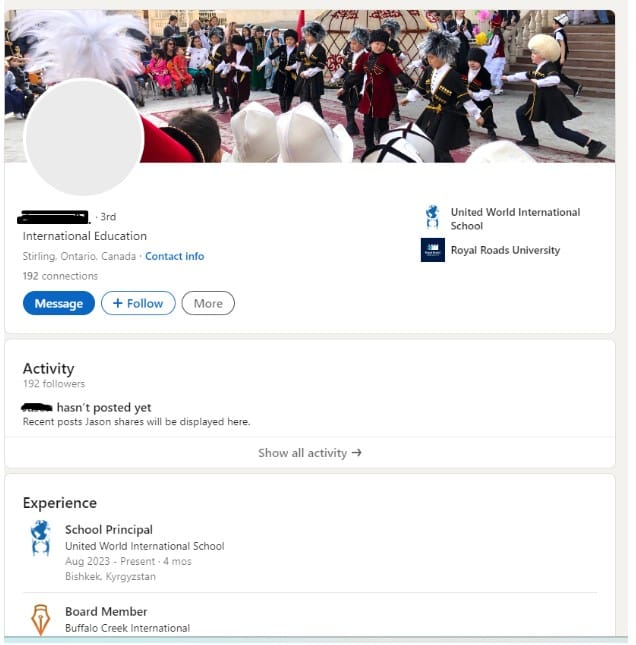
A profile can be a great way to create social proof and to let prospects get to know you better.
This is an easy win.
Have your employees update their Linkedin pages
When employees have a strong brand presence and post valuable content on Linkedin, it can also attract the right target audience AND create trust.
If your employees have killer profiles and share helpful content, potential customers will notice.
If users keep seeing your brand, and keep noticing that you’re posting relevant content that resonates with them, the chances of them reaching out to your company will be higher.
Here’s an example:
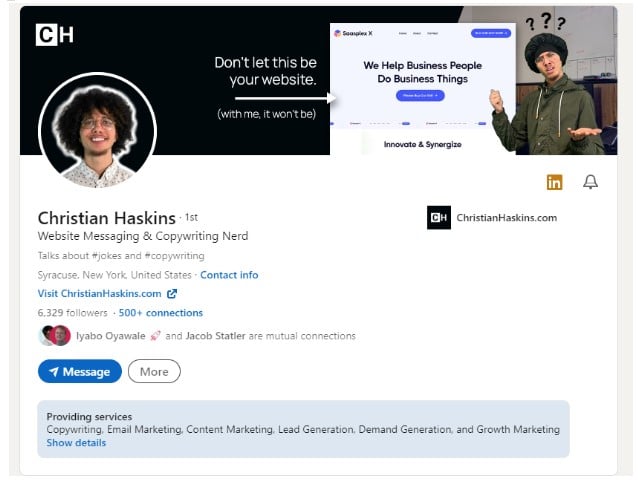
Christian Haskins posts tons of funny, relevant content on Linkedin about copywriting.
He creates informative videos that show he’s a leader in his field of marketing.
Because he posts regularly has generated a huge following within a few months.
If you can get your employees to do something similar, Linkedin users will notice and your brand will become the go-to leader in the industry.
Create a killer business profile page
Users prefer interacting with individuals on Linkedin, so first prize would be to create a great personal profile; but a business profile page can also be helpful.
Keep your page active with interesting posts and participate in ongoing discussions on LinkedIn.
Make sure your company’s details are up to date, as well as your logo.
You can use LinkedIn Pages as it’s a free tool that can boost your company’s visibility on the platform.
Use it to showcase your brand’s expertise with videos, executive insights, and helpful content from other sources.
Grow and Convert does this well, see the the example below:
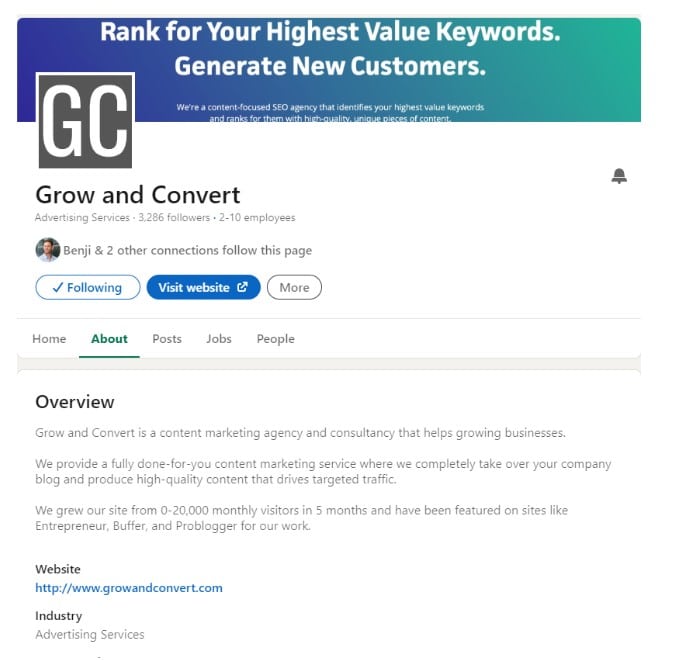
It’s a simple page that’s clear and to the point, showing users how they solve their clients’ pain points.
Join Linkedin groups
When you join industry-related groups and interact with members, potential customers can see your valuable insights and this inturn can foster trust in your business.
You can also utilize these groups to gain insights about your audience.
Listen to what active members are saying, identify common industry challenges, and understand how leads want these issues solved.
By using this information you can tailor your messages and create specific value propositions that directly address your customers’ needs when reaching out to them.
Connect with people who would be your ideal customer
Another way to find more leads is to actually connect with people who would be your ideal customers.
Some people make the mistake of connecting with just everyone, or only with users who are in the same profession as themselves, but we have noticed that when you connect with your ideal clients, you’re creating a profitable professional network.
When your ideal audience keeps seeing your content marketing efforts on Linkedin, they start noticing that you’re a thought leader in your industry.
Which inturn can bring in more high quality leads.
Invest in Linkedin lead generation tools
If you’re considering an outreach strategy then we suggest investing in prospecting tools such as:
- Linkedin Sales Navigator
- Expandi
- Apollo
- Bombora
- Crunchbase
These tools can help you build super refined lists that help you target qualified leads. We will go into more detail about list building a little later in the article.
Side note:
What about using automation tools for generating leads on Linkedin?
At Salesbread we only use automation to send follow-up messages, but we reply to prospects in real time. Also, all of our messages are written in house by our personalization expert.
This article: Should You Automate Linkedin Messages? (Plus 5 tools to avoid) goes into more detail on automation and how to use it the right way.
How to generate leads – Follow these strategies
Use this step-by-step LinkedIn outreach strategy for more qualified sales leads

Step 1: Build an ultra refined list of prospects based on current buyers data
Start by creating a list of potential customers by analyzing your current buyers.
Why?
Because reaching out to a large group of prospects increases the likelihood of failure.
The more precise and well-defined your prospect lists are, the greater the probability of success.
This translates to higher conversion rates for your business.
So how do you do this?
Have a look at WHO has purchased your product or service within the last 6 months; And then ask yourself:
“What do all these businesses have in common?”
- Are they located in the same area?
- Which industries are they in?
- Who is the decision maker?
- What’s the job title of the person buying from you?
- Do they make use of social media marketing?
- How many employees do they have?
- What’s the company size?
- Have they recently been funded?
- Do they use SEO in their marketing strategy?
- Have they made use of webinars?
- Do they use the same CRM? Like Hubspot or Salesforce?
Once you find patterns, it’s easy to build look alike lists of prospects.
The more refined your prospect lists are, the better chances of success. We would rather reach out to 100 prospects who agree to a booked meeting, instead of thousands of people who might be a bad fit.
Step 2: Build a list of people to target at each account
Next, identify the hottest prospects to reach out to at these accounts by using Linkedin Sales Navigator.
There’s a caveat here though. Be aware that the data provided by Sales Navigator can be unreliable if you don’t know how to use this powerful tool the right way.
After some A/B testing we noted that LinkedIn Sales Navigator is only 33% accurate.
This is why you have to double check the data to make sure it’s accurate. The video below goes into more detail.
This article also goes into more detail on how to use Linkedin Sales Navigator the right way.
Step 3: Write ultra personalized Linkedin outreach messages
At Salesbread, we always personalize our messages. Because of this, we have an average reply rate of 39% on LinkedIn.
It’s important to note that your messages shouldn’t come across as spammy.
But when you write something very specific for a prospect, your message stands out from every other salesperson on the platform.
How do you do this?
You actually have to research each person on your list and find something very specific about them to use in your connection request.
Yes, this takes time. But it’s worth it.
We actually have a personalization expert at Salesbread, who does just this. She researches each person, and writes ultra personalized messages.
Here are some examples:
1. Hey {{Name}}, since we’re both working in {{commercial real estate}} here in {{San Diego}}, I’d like to invite you to share my network here on LI.
2. {{Name}}, I’m looking to connect with like-minded professionals who are on the {{revenue-generating}} side of things. Let’s connect?
3. Hi {{Name}}, I’m looking to expand my network with fellow business owners in the {{HR Tech}} industry. Looking forward to learning more about what you do and see if there’s any way we can support each other.
4. Hi (Name) LinkedIn showed me your profile multiple times now, so I checked what you do. I really like your {{sales posts}} and would like to connect with you here.
5. Hey (Name) I hope your week is off to a great start, since we both work in the {{HR/Employee Experience}} field together, are you open to connecting?(My background is in employee retention, happy to share insights anytime.)
If you would like some more templates, read this article.
You can either compliment the prospect on something that they have achieved, or mention a commonality, or ask them a question.
This article goes into more detail on how to write outreach messages that get readers to reply. Using the C-C-Q Formula to Write 1000’s Personalized Sales Emails
Step 4: Follow up and ask for a booked meeting
The last step in our lead generation effort is to follow up every 3 days with personalized messages until the prospect responds (about 3–6 follow-ups max) and asks for a quick call.
Below are some examples of how we would do this:
1. {{First name}} good to connect. By the way, congrats on your new role at (company name.)
2. Good to connect {{first name}}. By the way, what are your favorite hiking spots these days?
3. {First_name}, good to connect. By the way, happy to give you an intro to anyone in my network now that we’re connected.
4. I’ve been researching {{xyz}}. We provide {{what your company does.}} Since we’re newly connected, I’d like to share this post with you: {{Share a link that’s helpful from your website.}} P.S. It explains {{xyz}}
4. Hi {first_name}, If you could help {company_name} with {{solution}} would that be worth a short conversation? I’m asking because of {{client’s pain point}}.
5. Thanks for connecting {{first name}}. I’d love to connect outside LinkedIn, too. Very curious to hear about where you get most of your {{xyz}}. What does your calendar look like to connect over the next week or two? PS: For background, my company does {{xyz}}.
If a prospect still doesn’t respond after let’s say 6 follow-up, you could always add them to a cold email campaign, or try to reach out to them via SMS.
When it comes to asking for a booked call, make the “ask” super low commitment. So instead of asking the prospect to watch an hour long webinar, you could ask them to watch a quick 30 second video.
Or ask for a quick 10 minute call at a convenient time for them. You could even ask for their calendar link.
Remember… When it comes to outreach, use linkedin in the way it was intended to be used. Linkedin is all about building relationships that expand your career. When you cut the sleazy sales pitches, new leads start becoming a common metric.
Side note: What about using InMail?
At Salesbread we prefer using connection requests, but we do use Inmail as a supplementary option to our outreach. When it comes to Inmail remember though that your copy writing has to be top notch.
You need to get to the point, cut the sleaze and add value to your messages. We also suggest using 1 easy to follow call to action.
Here are some InMail examples:
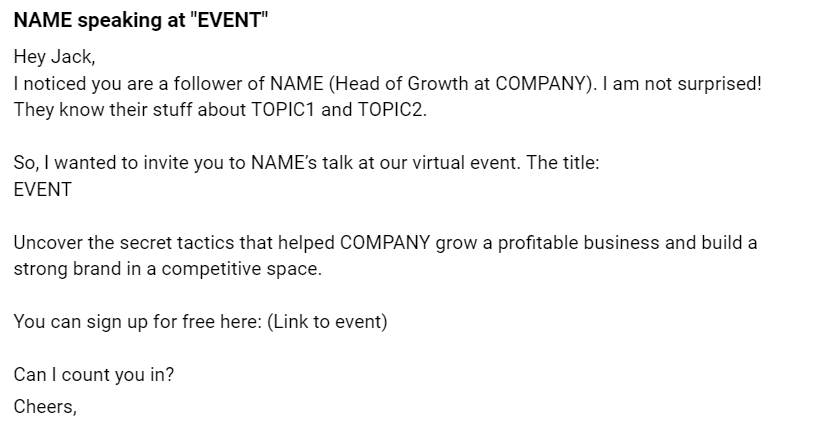
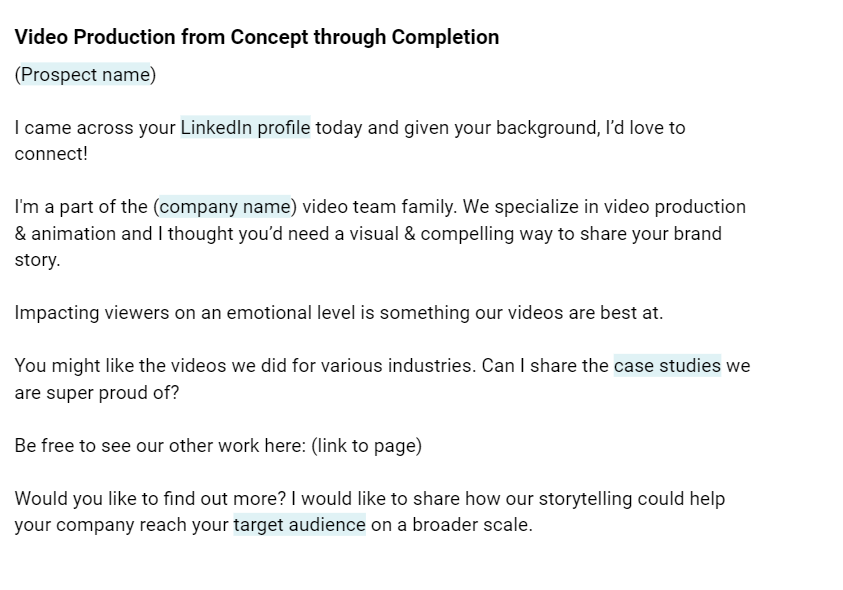
Linkedin Ads and content marketing
We don’t really encourage Linkedin ads for lead generation and the only reason for this is because we have had many clients come to us in the past and tell us that they had spent over $10 000 on Linkedin ads, and never even received 1 lead.
As you can imagine… This is terribly frustrating.
We aren’t saying don’t try it. It might work for you, but what we are saying is don’t spend a ton of time and resources on Linkedin ads.
Test it out for 3 months, and if it brings in potential leads, great; But if not try a different b2b lead generation tactic.
What about Linkedin content marketing?
Interestingly stats show that in the UK, 96% of B2B marketers are using LinkedIn as a
content marketing channel, with 61% saying they find it highly effective.
For example when you consistently share helpful content on your company page, or as a Linkedin post, you’re creating thought leadership. Linkedin users will begin to view you as a leader in your industry.
Besides just sharing helpful content, you can also direct users to your website, share whitepapers , eBooks, case Studies, industry articles and how to guide. This form of Linkedin marketing might have greater success than Linkedin advertising.
Below is a Linkedin content strategy that you can use for your digital marketing efforts, courtesy of Linkedin itself.

Need more leads?
Try out the above methods. And if you need some more advice, contact us for a free 15 minute strategy call.
We would love to help you find a guaranteed sales lead per day.
